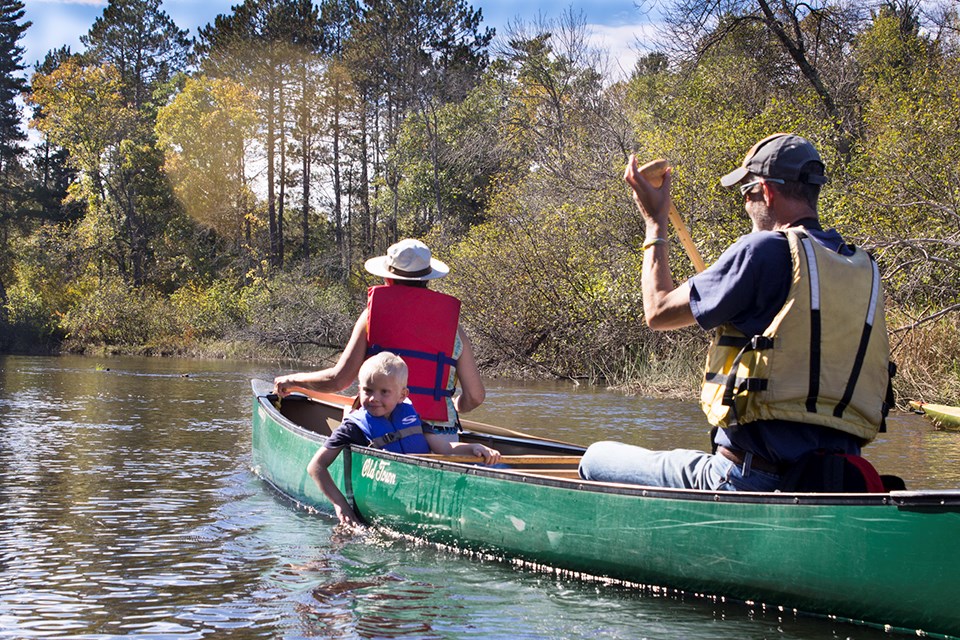Last updated: May 3, 2018
Article
Wild and Scenic Rivers Act

NPS/Jean VanTatenhove
Volunteer-In-Park
Maria DeLaundreau
Article
In 2018, we celebrate the 50th anniversary of the Wild and Scenic Rivers Act. Americans called for this legislation to protect the nation’s rivers when wild water bodies were at their most vulnerable, ensuring that beautiful, free-flowing rivers can be enjoyed to this day.The main threats to American rivers were development, diversion, and damming. Rivers continue to be important transportation routes and sources of fresh water, thus making them a magnet for development. Their waters have been diverted to irrigate crops, provide energy, and serve other commercial purposes. In the first half of the 19th century taller dams with larger reservoirs were built, further taming rivers. Many of these dams and water impoundments were created to support flood control, irrigation, stable water supply, and hydroelectric power. Domesticating rivers was considered a standard for “progress,” and the associated pollution was deemed a necessary, if unfortunate, byproduct of modernization.
The degradation of America’s rivers was alarming. The Cuyahoga River in Ohio was so highly polluted it caught fire 13 times between 1868 and 1969. The 1969 fire coincided with an environmental awakening throughout the nation and became national news. The coverage brought attention to the state of American rivers.
Recognizing the need for rivers without large dams, the Secretaries of Agriculture and Interior studied the nation’s rivers, and in 1965 recommended that several rivers possessing exceptional outdoor recreational values should be protected from damming.
The St. Croix River and its largest tributary, the Namekagon, were among the first recognized for their natural beauty, biodiversity, and outstanding recreational opportunities that should be preserved. St. Croix supporters had to act quickly to save the rivers as the area was developing rapidly. In the 1960s the Army Corps of Engineers proposed a plan that would make a 30-mile long reservoir in this river system. A power plant was also in the works. Congressman Alvin O’Konski of Wisconsin spoke out to defend the St. Croix, arguing “Our precious heritage of natural and unspoiled beauty and unpolluted streams, once exhausted and destroyed, can never be replaced… We have a golden opportunity to save the few remaining scenic and wild rivers as part of our nation's heritage for this and coming generations.” Senator Gaylord Nelson (WI) also advocated fiercely for protecting the St. Croix and Namekagon Rivers. He took Secretary of the Interior Stewart Udall paddling so Udall could see firsthand why these wild waterways were so special, and reinforce his commitment to wild and scenic rivers.
Senators Walter Mondale (MN) and Frank Church (ID) championed the Wild and Scenic Rivers Act, and garnered strong support from river enthusiasts like Gaylord Nelson. Senator Church understood developing waterways provided economic benefits, but urged Americans to think about the bigger picture, stating “The affluent society has built well in terms of economic progress, but has neglected the protection of the very water we drink as well as the values of fish and wildlife, scenic, and outdoor recreation resources. Although often measureless in commercial terms, these values must be preserved by a program that will guarantee America some semblance of her great heritage of beautiful rivers.”
Advocates across the nation successfully built the case for protecting rivers, and in 1968 the Wild and Scenic Rivers Act become law. In the act policymakers justified and explained the importance of this legislation, "The Congress declares that the established national policy of dam and other construction at appropriate sections of the rivers of the United States needs to be complemented by a policy that would preserve other selected rivers or sections thereof in their free-flowing condition to protect the water quality of such rivers and to fulfill other vital national conservation purposes."
This law declared river stretches could be protected to preserve their wild, scenic, and/or recreational attributes. These attributes represent a gradient of protections for portions of rivers dependent on the amount of impoundment, accessibility, shoreline and watershed development, and water quality. The law requires these characteristics be protected or enhanced, ensuring that river quality will remain high or improve over time.
Today, the Wild and Scenic Rivers Act successfully protects over 12,000 miles of river. Americans no longer worry about burning rivers, wildlife habitat is improved, and the US has thousands of wild and scenic river miles to paddle, float, fish, and enjoy.
To honor our outdoor heritage and special milestone, we invite you to visit designated Wild and Scenic Rivers during their 50th anniversary. Join us in their waters and along their shores to understand the inspiration for this act, and strengthen or forge your own connection with our great heritage of beautiful rivers. They’re your rivers. Make your splash!
Sources
http://scholarship.law.cornell.edu/cgi/viewcontent.cgi?article=3816&context=clrhttp://time.com/3921976/cuyahoga-fire/
https://open.mitchellhamline.edu/cgi/viewcontent.cgi?article=1361&context=wmlr
Tags
- wild and scenic act
- 50th anniversary
- st. croix national scenic riverway
- st. croix river
- namekagon river
- wisconsin
- minnesota
- senator waler mondale
- senator frank church
- senator gaylord nelson
- walter mondale
- frank church
- gaylord nelson
- stewart udall
- congressman alvin o'konski
- alvin o'konski
- cuyahoga river
- legislation
- wild
- scenic
- recreation
- watershed
- water quality
- habitat management
- paddle
- float
- fishing
- wild and scenic rivers
- wild and scenic
- wild and scenic rivers program
